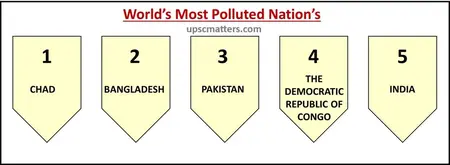The 2024 World Air Quality Report has cast a stark spotlight on India’s escalating air pollution crisis, with PM2.5 levels soaring 10 times above WHO safety limits and Delhi retaining its title as the world’s most polluted capital.
India’s Global Air Quality Ranking 2025: 5th Most Polluted Nation

- Rank: India remains among the top 5 most polluted countries globally (ranked 5th).
- In 2023, India was the third most polluted country
- PM2.5 Levels: National average PM2.5 concentration is 50.6 µg/m³ (over 10x WHO’s safe limit of 5 µg/m³).
Key findings from the 2024 World Air Quality Report:–
- Published by IQAir, a Swiss air quality technology company,
- Only 17% of global cities meet WHO air pollution guideline.
- Seven countries met the WHO annual average PM2.5 guideline of 5 µg/m3: Australia, Bahamas, Barbados, Estonia, Grenada, Iceland, and New Zealand.
- South Asia Dominance: 17 of the top 20 polluted cities globally are in South Asia (India, Pakistan, Bangladesh).
- The five most polluted countries in 2024 were:
- Chad (91.8 µg/m3): More than 18 times higher than the WHO PM2.5 annual guideline.
- Bangladesh (78.0 µg/m3): More than 15 times higher than the WHO PM2.5 annual guideline.
- Pakistan (73.7 µg/m3): More than 14 times higher than the WHO PM2.5 annual guideline.
- Democratic Republic of the Congo (58.2 µg/m3): More than 11 times higher than the WHO PM2.5 annual guideline.
- India (50.6 µg/m3): More than 10 times higher than the WHO PM2.5 annual guideline.
2024 World Air Quality Report–Top 6 out of 10 Most Polluted Cities in India (2025):

- Byrnihat (Meghalaya): Byrnihat, India was the most polluted metropolitan area of 2024, with an annual average PM2.5 concentration of 128.2 µg/m3.
- The region of Central & South Asia was home to the top seven most polluted cities in the world.
- India was home to six of the ten most polluted global cities.
- Delhi: The national capital retained its position as the most polluted capital city globally.
- Between 2018 and 2024, New Delhi has topped the list — except in 2022 when N’Djamena edged past it.
- Indo-Gangetic Plains remain India’s pollution hotspot due to stubble burning, industrial emissions, and weather conditions.
PM2.5 Levels in India 2025: 10x Higher Than WHO Guidelines
- WHO guidelines- While (WHO) annual guideline for PM 2.5 is 5 micrograms per cubic metre (µg/m3), India’s Central Pollution Control Board has set it at 40 µg/m3.
- Marginal Improvement: India’s average PM2.5 concentration in 2024 was 50.6 µg/m³, reflecting a 7% decrease from 2023 (54.4 µg/m³).
- Major sources of PM 2.5 include combustion engines, power generation, industrial activities, crop burning and agricultural practices, and wood and coal burning.
Note- Doctors say there are no safe levels of PM2.5, which is small enough to slip into the bloodstream and damage organs throughout the body, but have estimated millions of lives could be saved each year by following their guidelines. Dirty air is the second-biggest risk factor for dying after high blood pressure.
Health and Economic Impact of air pollution
- Health Burden: Air pollution caused 1.6 million premature deaths in India in 2025 (highest globally).
- Economic Loss: Cost India 3% of its GDP (healthcare, productivity loss, and crop damage).
Policy and Governance Insights
- Success Stories: Chennai and Mumbai saw PM2.5 reductions due to coastal winds and stricter waste management.
- Challenges: Poor enforcement of emission norms, subsidized diesel, and slow adoption of electric vehicles (EVs).
New Initiatives:
- Expansion of NCAP to 200 cities by 2026.
- Green Hydrogen Mission to curb industrial emissions.
Indo-Gangetic Plains: India’s Persistent Pollution Hotspot
- North India: PM2.5 levels 2x higher than southern states (e.g., Karnataka, Kerala).
- Rural vs. Urban: Rural areas face rising pollution due to biomass burning and lack of monitoring.
Sustainable Solutions: Green Hydrogen Mission and EV Policy.
- Strengthen interstate coordination to tackle stubble burning.
- Accelerate EV infrastructure and phase out coal-powered industries.
- Integrate air quality with urban planning (e.g., green spaces, public transport).
- Enhance real-time data monitoring in rural areas.
UPSC Relevance: Linking Air Pollution to SDGs and Federalism
- PM2.5/PM10: Particulate matter linked to respiratory diseases.
- NCAP: National Clean Air Programme (2019).
- GRAP: Graded Response Action Plan (for Delhi-NCR).
- AQI: Air Quality Index categories (Good to Severe).
- Links to SDG 3 (Health), SDG 11 (Sustainable Cities), and SDG 13 (Climate Action).
- Questions on environmental governance, federalism, and public health policies.
- Case studies on Delhi’s smog crisis or Chennai’s improvement model
If you found this helpful, you might also like these articles:
📌 [ https://upscmatters.com/pink-fire-retardants-in-wildfire-management-upsc/]
📌 [ https://upscmatters.com/india-ranked-118th-in-world-happiness-index-2025/]
They cover key concepts that will boost your preparation! 🚀
📢 Stay Updated with the Best UPSC Resources!
Join our Telegram Channel for:
✅ Daily Current Affairs
✅ Important Notes & PDFs
✅ Answer Writing Tips
✅ Strategy & Motivation
📲 Click the link to join now: [https://t.me/upscmatters] or [https://t.me/ramsirnotes]
Don’t miss out on valuable updates! 🚀
